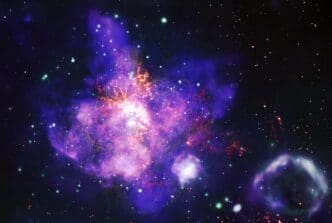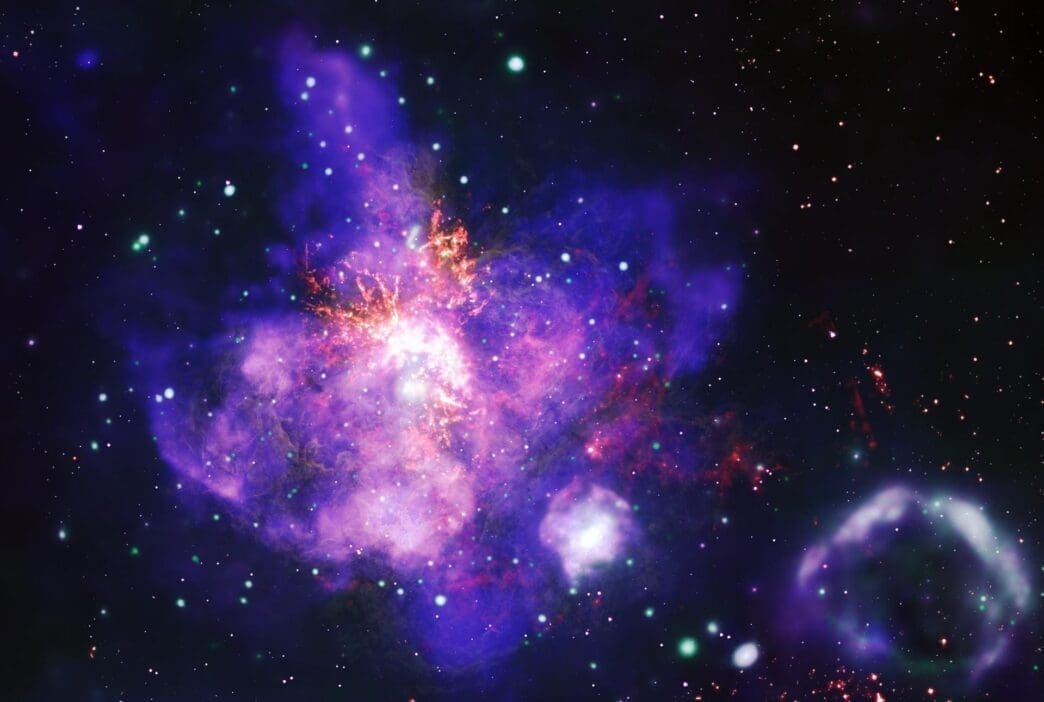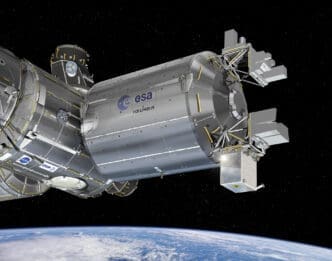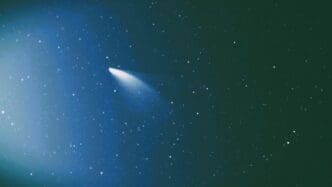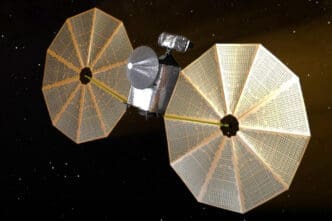In the heart of space lies a mesmerizing wonder known as 30 Doradus or the Tarantula Nebula. This star-forming region, residing about 160,000 light-years away in the Large Magellanic Cloud, serves as a cosmic laboratory for curious astronomers. With recent technological advancements, mankind has peered deeper than ever into its intricate dance of birth and decay.
NASA’s Chandra X-ray Observatory has unveiled the deepest X-ray image of this space marvel, bringing together data from various wavelengths. This image offers fresh insights into the nebula’s complex composition. Through a symphony of colors, this celestial bouquet captures our imagination, intertwining both science and art.
The Jewel of the Magellanic Cloud
30 Doradus, lovingly called the Tarantula Nebula, captivates with its sheer brilliance and scale. Its nickname is derived from its spider-like shape visible from Earth. A vibrant gathering of newborn stars and swirling gas, this region shines bright in its galactic neighborhood. A focal point for astronomers, it invites numerous studies on stellar evolution.
Nestled within the Large Magellanic Cloud, 30 Dor is easily one of the most studied star-forming areas in the universe. Its vastness and brightness lend invaluable insights into how stars take shape and mature. Every observation peels back another layer, revealing secrets held by its cosmic dust and gas.
For generations, 30 Doradus has been a muse, combining poetry and science. Each snapshot taken is but a glimpse into the dynamic forces at play. Its appeal lies in its ability to blend simplicity with profound complexity. It’s a testament to the universe’s beauty and chaos rolled into one cosmic picture.
Unveiling the X-ray Universe
The use of X-rays allows scientists to look beyond the nebula’s visible surface, into its energetic heart. This depth of observation is unparalleled. By combining data from multiple sources, a clearer picture emerges. The technology offers a new way to understand the universe’s mysteries and energetic processes.
Chandra’s observation reveals hot gases and newborn stars hidden within the swirling clouds. This image provides a new understanding of these cosmic giants. What was once concealed in space’s dark reaches is now illuminated by science.
The combination of X-ray, infrared, and optical data enhances the clarity of celestial images. These multi-wavelength observations unravel mysteries hidden for eons. Scientists rely on these composite images to piece together the life cycles of stars. With each revelation, a new question emerges.
Infrared and Optical Wonders
Infrared technology captures the dust that X-rays cannot, adding another layer to the image’s depth. Together with optical data, it paints a more complete picture of the persistent drama unfolding in space.
Optical images from NASA’s Hubble are critical for viewing the Tarantula Nebula. Their precision contributes significantly to our understanding. The vivid readings showcase intricate patterns of light and shadow.
The dance of light captured in these images tells stories of ancient star births. Each burst of light indicates transformations within the nebula. Merging these data points offers an all-encompassing view of this stellar nursery.
The Role of Radio Waves
Radio waves reveal another aspect of the Tarantula Nebula by penetrating even thicker cosmic dust. They provide data on the movement and formation of gases.
The Atacama Large Millimeter/submillimeter Array contributes to this multi-faceted portrayal. Its inputs show the shifting dynamics of gas clouds. As they swirl, they highlight the ongoing crafting of stars.
Observing at multiple wavelengths is essential for astronomy. It breaks down complex cosmic processes. Each observation brings awe and deepens our understanding of space.
A Collaboration Across Space and Time
This project exemplifies collaboration among numerous observatories, each contributing unique observations. Such teamwork advances our grasp of the cosmos. It’s a collective effort where every entity plays a pivotal role.
Images from Chandra, Hubble, and ALMA combined, provide a holistic view. Each observatory adds a colorful piece to the cosmic puzzle. Together, they create a masterful depiction of the universe.
The persistent endeavor to study space unmasks the secrets housed in stellar nurseries. It bridges technology and human curiosity, pushing the boundaries of known science.
Beyond Astronomical Beauty
The stunning imagery is not merely for admiration. It serves as a laboratory for budding scientists. Each photograph holds potential for future research, inspiring countless projects and hypotheses.
It’s a starting point for developing innovative technologies. With every discovery, the need for more advanced tools becomes apparent. Each leap in methodology leads to profound revelations.
By understanding stellar processes, we edge closer to answering fundamental questions about the universe. The pursuit of knowledge requires relentless exploration and deep curiosity about our cosmic origins.
Astrophysical Insights and Discoveries
Study of 30 Doradus provides insights into star formation mechanisms. It offers a peek into the lifecycle of celestial bodies. Each observation contributes to unraveling centuries-old mysteries about stars.
Research on this nebula helps refine existing models of stellar dynamics. Insights gained are crucial for developing future exploration strategies and technologies.
Each observation enriches our comprehension of the universe’s function. These studies influence how we perceive the cosmos.
Learning from such areas contributes to a broader understanding of our own galaxy’s history. Every piece of data, whether minute or monumental, is invaluable.
Exploration of 30 Doradus enhances our grasp on cosmic evolution. It’s an ongoing journey that reveals more than just the stars—it unfolds the story of time and space.
The Artistry of the Universe
There’s undeniable artistry in how the universe forms stars. These regions, full of chaos and order, are natural masterpieces. They ignite wonder and creativity in every observer.
Photographs of 30 Doradus are galleries of universal wonders. Each star, each cloud of gas, tells tales from eons past. The art of astronomy captures these stories for generations to marvel.
The spectrum of colors and forms seen through telescopes is breathtaking. Such images are reminders of the magnificent forces governing celestial mechanics. They ensnare our curiosity and never let go.
Continuing the Voyage of Discovery
As technology evolves, so does our ability to interpret the universe’s messages. With each advance comes the promise of new discoveries and deeper insights.
The Tarantula Nebula remains a focal point. Every new look promises fresh data. This continuous exploration speaks volumes about our species’ insatiable curiosity.
The cosmic voyage never ends with galaxies far and near still to be explored. Together, humans and technology journey persistently further into the unknown.
This stellar bouquet, represented by 30 Doradus, is more than a cosmic spectacle; it is a treasure trove of scientific potential. It invites explorers and captivates dreamers, ensuring that its mysteries will unfold for generations to come.

